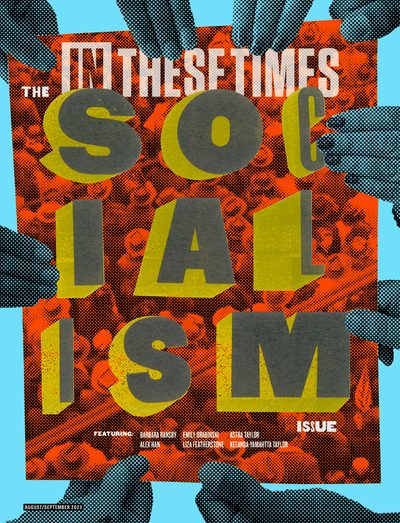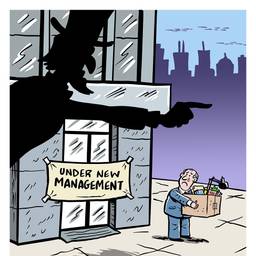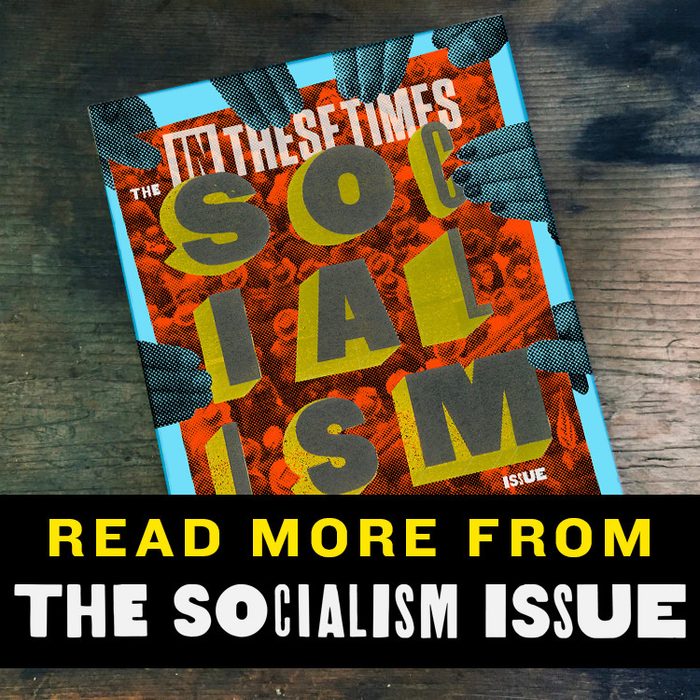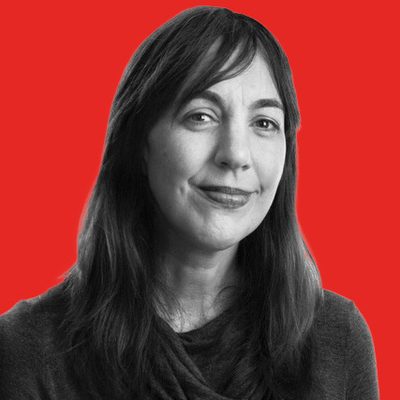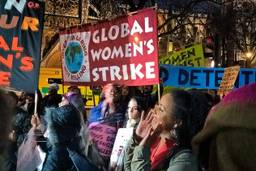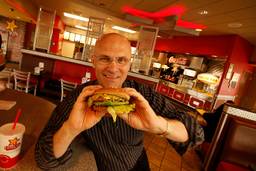New York Socialists Won Big On Climate. How Did It Happen?
We don’t have to settle for neoliberal half-measures.
Liza Featherstone
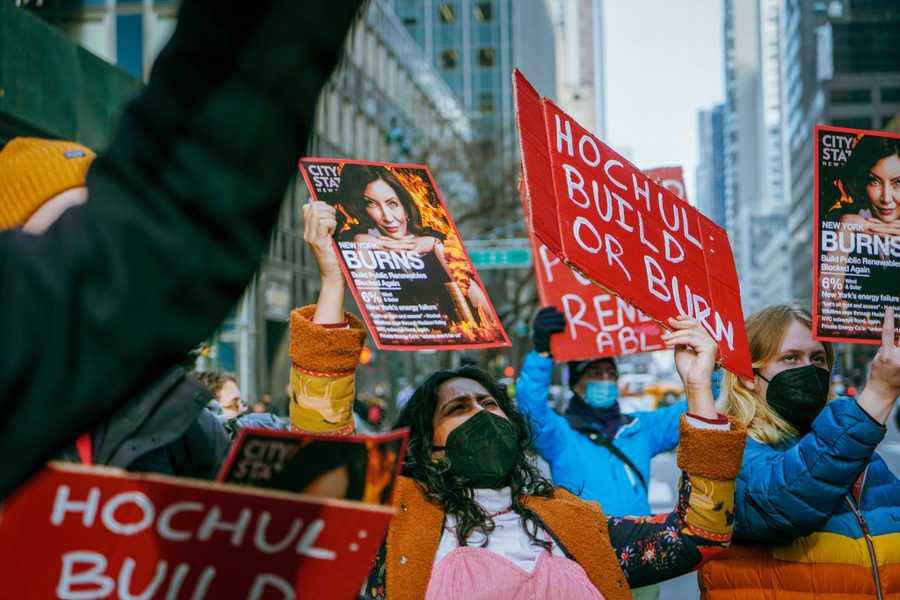
Demonstrators rally at NYC-DSA’s “Build or Burn” protest on January 13 with imagined City & State magazine covers portraying Gov. Kathy Hochul’s inaction on climate policy. Photo by Elliott Golden

NEW YORK CITY — Anyone perusing Twitter or reading the works of Karl Marx will notice that socialists can get fractious with one another. But as one hardworking ecosocialist leader in the New York City chapter of the Democratic Socialists of America (NYC-DSA) will tell you, an existential threat to humanity like climate change can bring people together. “It’s not like we’re debating about Lenin,” Charlie Heller joked over coffee in June (though he acknowledged his comrades did have diverse perspectives on Lenin).
“Something about being focused on climate makes you crazy in a unique way,” Heller says. “We are here to win and we have to seize the power of the state, because nothing else can address this global crisis at a scale that can match it.”
Heller was reflecting on a major ecosocialist victory, a phrase that would have seemed oxymoronic five years ago. That victory was New York state’s Build Public Renewables Act (BPRA), a big step toward a Green New Deal. While other states have taken steps as well — Illinois’ 2021 labor-led Climate and Equitable Jobs Act comes to mind — New York is the first state to do so in a way that explicitly rejects the neoliberal obligation to put corporate profits first. Instead, the BPRA puts the publicly owned New York Power Authority in charge of building renewable energy with a mandate to do so in the interest of working people.
Ecosocialists in New York won because their goal was unabashedly socialist, because they’d built a bench of elected leaders, and because they were willing to try everything — even with great risk — while rethinking strategies that weren’t working.
Where to start
In 2017, as DSA membership skyrocketed in the wake of the Bernie Sanders presidential campaign, a handful of DSA members formed a national ecosocialist working group. It seemed clear that capitalist profiteering was fueling the climate crisis, confirmed by a 2017 study that found that just 100 corporations had produced more than 70% of total greenhouse gas emissions since 1988.
A socialist solution felt urgent. For decades, leaving the problem to the capitalist elites who caused it had yielded mostly empty greenwashed rhetoric.
But even within DSA, not everyone was convinced climate should be a focal point. The question (shared by centrist Democrats at the time) was whether climate, as a broad issue, could mobilize working-class Americans. “It sounds crazy to say now,” said Mike Paulson, one of the leading strategists on BPRA and an early member of the Ecosocialist Working Group, “but four years ago, a lot of socialists just didn’t care about climate. So we had to prove ourselves within DSA.”
In 2018, these attitudes began to change quickly. Alexandria Ocasio-Cortez, a democratic socialist bartender and a Standing Rock protester, won a congressional seat in Queens and championed the idea of a Green New Deal. It was the first time a U.S. elected official had proposed a plan to decarbonize the economy that matched the scale of the climate crisis.
Meanwhile, more and more young people were painfully aware of the climate crisis. Paulson remembers this time well. “I was becoming increasingly despondent,” he says. “It’s really dark to confront that without any framework for thinking about how there could be anything other than a totally disastrous future.”
By the end of 2018, it was clear that DSA had a good model for socialist electoral work, having won 46 electoral victories that year, from the local to the federal level. And socialists have had a model of how to organize workers for more than a century. “So the question was,” Paulson recalls, “how would socialists do climate work?”
With Trump as president, demanding a Green New Deal felt too ambitious, potentially demobilizing in its impossibility. They needed an intermediate step. They considered some proposals on composting and on transportation, but to demand something too small could squander the sudden momentum of the socialist movement. Heller recalls the group wondering, “What is the biggest thing that we could conceivably win?”
The most powerful idea to emerge from these discussions was a public power campaign. It would be modeled on a fight in Providence, R.I., known as #NationalizeGrid, which was waged by Providence DSA (now Rhode Island DSA) and the George Wiley Center. (That project has stalled because of the chapter’s shift in focus toward Medicare for All and medical debt, but the project did succeed in reducing a proposed rate hike.)
Because utility profiteering affects everyone, and because it disproportionately affects working-class New Yorkers, the issue is a natural fit for a socialist organization. Plus, a public takeover would open the door to a green energy transition.
While Providence was the inspiration, the model for how to win legislation in Albany was closer to home: the 2019 rent laws. Championed by democratic socialist Julia Salazar, the first of the recent wave of DSA-endorsed candidates to win state office in New York, the new reforms made New York’s tenants possibly the best-protected in the country. In a state where the real estate industry is easily the most powerful interest group, the fight was won through targeted canvassing of rent-stabilized tenants, to build awareness and organize pressure on politicians.

The New York power campaign canvassed in neighborhoods suffering unreasonably high electric rates and the fallout of climate disasters. The devastating 2019 blackout in New York City left many stranded in elevators and subways, which revealed — according to Amber Ruther, then an NYC-DSA member who was part of the early organizing— that ConEd, a for-profit company with a monopoly, “didn’t have the incentive to invest in even basic grid maintenance.” Public power advocates argued that the government, without the profit motive and with democratic oversight and obligation, could do a better job. (Ruther, now of Syracuse DSA, also works for Alliance for a Green Economy, part of the Public Power coalition that worked to pass BPRA.)
The campaign also held town halls in affected neighborhoods. It turned out that ConEd had kept the lights on in wealthy areas but had cut off power in working-class Black communities like Flatbush. Ruther recalls “a lot of righteous anger from the community about those blackouts” during town hall events. As one Flatbush resident interviewed for a DSA video put it, “Why are we always in the dark?”
Also in 2019, newly empowered progressives in Albany passed an ambitious-sounding climate law requiring New York to reduce its economy-wide greenhouse gasses 40% from 1990 levels by 2030, and 85% by 2050. The Climate Leadership and Community Protection Act (CLCPA) wasn’t as groundbreaking as it sounds, accompanied by few enforcement or operational mechanisms. That is typical of many climate pledges in a neoliberal system, which depend largely on voluntary corporate action.
But the CLCPA did hand socialists an argument: At the time, wind and solar made up less than 6% of New York’s energy, and complying with the new law would take massive systemic change. If New York didn’t enact public power, socialists said, the state would be breaking its own law.
Outsiders in Albany
The 2020 elections expanded DSA’s Albany slate to six (and put Jamaal Bowman, who played an unusually vocal role in advocating for BPRA, in Congress). New York’s socialists were in a unique position, with more elected officials than anywhere else in the nation, though far from a governing majority. The evolving idea of the BPRA began to attract support from some other Democrats in Albany, especially as DSA demonstrated more political power.
So DSA began experimenting. During one town hall event, Mike Gianaris, a state senator from western Queens, was put on the spot and asked whether he would support BPRA. With the growing electoral muscle of DSA in Queens, Gianaris agreed.
But not every tactic worked. DSA had previously been successful in some campaigns by organizing constituents to call their representatives. On BPRA, this approach wasn’t effective, perhaps precisely because of those previous DSA successes: Politicians had started to get hardened against mass outreach from constituents.
Still, DSA’s newly elected slate was already learning how to challenge the culture of Albany. One of these new socialist officials, Assemblymember Zohran Mamdani, from Astoria, Queens, says colleagues were puzzled by his lobbying for BPRA, since he wasn’t the sponsor — legislators customarily spent political capital only on their own bills. When he called them, they’d say, “Why are you calling me? It isn’t your bill.”
Assemblymember Robert Carroll, a member of the relevant committee who had agreed to sponsor the bill, was a committed progressive and an “incessant champion” of the bill, Mamdani says, but the socialist politicians saw themselves as a necessary part of the inside-outside pressure required.
Such matters of etiquette were not the only challenges for the neophyte lawmakers. BPRA’s sponsor in the state Senate, Kevin Parker, chair of the energy and telecommunications committee, wasn’t a socialist or a passionate supporter of public power, Heller says, but DSA activists didn’t realize how little good faith Parker brought with him. According to Heller, Parker committed to pushing BPRA if the group could get other legislators to support it. But when the DSA members approached other elected officials, Heller says, they were told no one supports a bill unless the lead sponsor asks them to.
“He just lied to us,” Heller says. “We realized that, even though we’re socialists, we weren’t cynical enough. The Democrats in Albany didn’t want to pass a climate bill because there was too much money on the other side.”
DSA activists analyzed data from the National Institute on Money in Politics and found that New York state’s Democratic campaign committees had taken more than $600,000 from the energy industry since 1997. Parker himself had received more than $110,000 since his first electoral campaign in 2002. (Parker did not respond to a request for comment on this story.)
The activists asked one sympathetic senator (outside of DSA) what they should do. Should they continue playing nicely, or would a negative campaign be more effective? The response: “Going negative is always better.”
DSA activists held a sizable demonstration in 2021 with protest signs that depicted some of the politicians standing in the way of BPRA — their faces on Venmo graphics listing all of their fossil fuel donations. The rally won both media and political attention. “They were fun, they were funny,” recalls Paulson, “and the people targeted were extremely upset.” BPRA did not pass in 2021, but it did move from being a fringe campaign to a focus of media attention.
Throughout this time, the group often discussed and rethought their approach, with many strategy retreats. According to Gustavo Gordillo — part of DSA’s Green New Deal committee as well as its National Political Committee — the questions they asked were, “What are the major conditions we’re facing? How much power do we have? Can we win? What do we need to do to win?” The openness, Gordillo says, “allowed us to be very honest with ourselves and made the strategy a lot better.”
Making them fear you
In January 2022, as the group decided to continue the negative, confrontational approach, DSA organized a big “Build or Burn” protest with signs putting new Gov. Kathy Hochul’s face on two fake City & State magazine covers: One, in which Hochul failed to pass BPRA, featured a burning background, while the other depicted a happier scenario in which Hochul did the right thing. The message was, Heller says, “If you don’t pass this, you’re evil. You’re condemning our future.”
These tactics made headlines, but the group realized they needed to do more. “Yes, you can upset people with the Venmo boards,” says Paulson, “but how do you make them fear you?”
To build their bench of socialist elected officials and to strike fear into the hearts of Albany lawmakers, DSA decided to primary Kevin Parker, the BPRA bill’s main sponsor — “not a Sierra Club move,” laughs Lee Ziesche, a DSA member and spokesperson for the Public Power coalition, who has also worked with Sane Energy. This move was controversial within the organization; turning on people who were, on paper, allies of the cause defied conventional wisdom. But in a series of heated meetings, they hashed it out, and the idea carried the day. They chose to run David Alexis, a serious, charismatic rideshare driver and organizer whose daughters suffered from asthma.
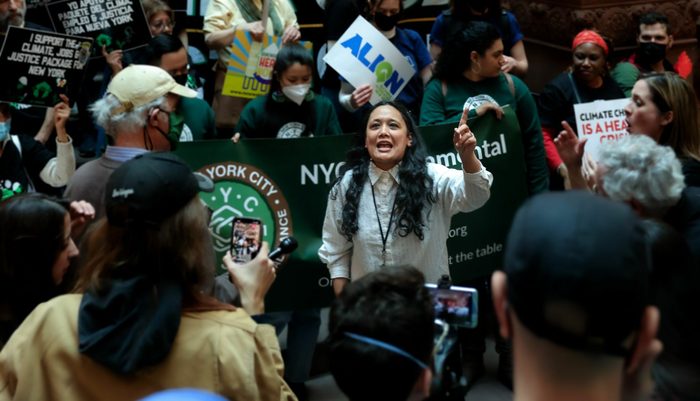
The group ran other ecosocialists for office in 2022, an effort that took enormous organizing capacity. Many quit their jobs to work full-time on these electoral campaigns, all of which were extremely organizing-intensive, with door-to-door outreach throughout the city and upstate. Only two of seven candidates won their seats. The experience led many to wonder whether the diversion of BPRA organizing into electoral work had been a mistake: “We did way too many campaigns and most of them lost,” says Heller, “which sucked.”
But the electoral campaigns turned out to be crucial to BPRA’s eventual passage in ways no one anticipated. The political effects became especially apparent during the June 2022 Democratic primary.
Sarahana Shrestha, in her Hudson Valley campaign for state Assembly, made climate and BPRA her main platform planks, defying conventional wisdom that climate was not a kitchen table issue, especially outside of the city. Plus, her opponent was already known in Albany as a climate advocate— not the sort of politician that conventional environmentalists would oppose. But Shrestha won the primary, and her victory became understood as a mandate for BPRA and a warning to politicians who didn’t get on board. Shrestha became the bill’s biggest champion in state government.
In Queens, Kristen Gonzalez, a DSA activist who’d been a leader in a successful campaign to block fossil-fuel giant NRG from building a new gas plant in Astoria, also won her primary, crushing Elizabeth Crowley, an unremarkable mainstream Democrat (and a cousin of Joe Crowley, the incumbent machine boss ousted by Alexandria Ocasio-Cortez in 2018). Gonzalez’s state Senate victory — and the size of it — was a huge show of power for NYC-DSA. It scared mainstream Democrats and was a crucial reason why labor unions began taking BPRA more seriously.
Despite DSA’s efforts to bring unions on board as early as 2018, parts of labor had opposed BPRA, reticent because they did not believe DSA and its allies were powerful enough to ensure strong labor protections in the bill. Within DSA, the question of whether to keep campaigning for the bill without labor’s support was a fraught one.
The strong electoral challenges of 2020, and especially 2022, brought labor to the table. The labor provisions of the final BPRA bill were written by the AFL-CIO and include strong labor standards for the new public renewables sector, as well as an Office of Just Transition to train workers for the new jobs. Equally important, labor’s turn brought many Democrats in Albany on board. The New York State United Teachers’ full-throated endorsement of BPRA in April 2022 was an especially key turning point in winning over many legislators.
David Alexis lost his primary to Kevin Parker, but the campaign served its purpose of instilling fear. In the middle of the legislative session, a few weeks before the primary, Parker decided to bring the bill to a vote in the state Senate, removing what had appeared to be its biggest obstacle. In advocating for BPRA’s passage, Parker even used DSA talking points, insisting that BPRA would allow the state to meet its climate goals and that converting its grid to renewables was “imperative.”
The bill passed. DSA’s most maverick move — the primary challenge to BPRA’s lead sponsor — had worked, to the astonishment of many within the organization.
Says Gustavo Gordillo, regarding the Albany establishment, “We found out that the way to get them to do what we want is by open conflict that they can understand.”
Although leadership in the Assembly, the lower house of the state legislature, still refused to introduce BPRA, DSA had built enough power that Sarahana Shrestha and other socialist legislators were able to press for a hearing. Shrestha says that hearing in itself was a sign of how far the Albany common sense had evolved, although, she emphasized, “that was before the Inflation Reduction Act passed and definitely before we knew what it meant.”
The federal Inflation Reduction Act (IRA), passed in August 2022, provides direct funding for any public agency that builds renewable energy. The Public Power coalition commissioned a report revealing that failing to pass BPRA would cost the state billions of dollars in federal funds, a convincing argument for many in state government. At that point, Shrestha emphasizes, “the consensus was moving toward this bill.”
The Assembly still refused to bring it to a vote. But the visibility of the issue continued. #BPRA became a top trending hashtag on Twitter in New York, even ahead of #NationalDonutDay.
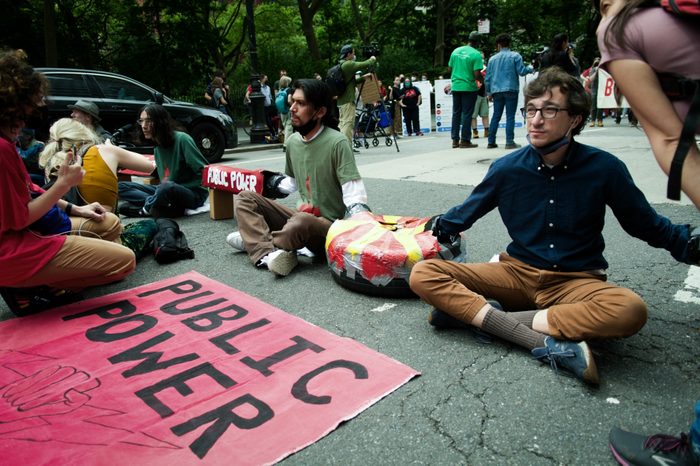
In January, confirming the labor movement’s fears, Gov. Hochul tried to remove BPRA’s labor and environmental justice provisions. This watered-down version of the bill became known by activists as “BPRA-lite.” BPRA-lite took the coalition by surprise. It was clear that the governor was trying to divide the labor, socialist and environmental forces backing the bill. They couldn’t allow that to happen.
The usual approach in Albany by progressive lobbying forces would have been to take BPRA-lite as a partial victory, but DSA and the Public Power coalition took the opposite approach. They saw that Hochul was vulnerable and put up a billboard in Albany pointing out that 68% of New Yorkers supported BPRA, while only 52% voted for the governor.
In May, BPRA passed with nearly everything DSA wanted, including the closure of six power plants causing asthma in Black and brown communities. BPRA creates thousands of well-paid, green, union jobs and imposes annual checks to ensure New York is on track to meet the decarbonization targets mandated in 2019 (70% renewable by 2030, 100% clean by 2040), which had previously seen little progress.
Shrestha emphasizes that BPRA’s passage is “not the end” of the fight. “Now,” she says, “we have to work to make sure that, every step of the way, this is implemented correctly, something that I find very exciting.”
The horizon of the possible
BPRA poses a challenge to most people’s modest assumptions about what is possible to win in the United States — how far the government will veer from serving the interests of the capitalist class. Many people want climate action, and many also want more socialist policy. “They just don’t think that’s possible,” Heller says. As Gordillo emphasizes, “We were able to challenge the ideological consensus.”
Winning a huge victory like BPRA also helps counter “doomism,” the idea that it’s too late to fix the climate crisis, which, Heller believes, is “the worst” of many prevalent climate narratives because it convinces people that “we don’t have to do anything.”
BPRA isn’t precisely replicable in every state. Franklin D. Roosevelt created the New York Power Authority when he served as governor of New York — which became a precursor to such New Deal projects as the Tennessee Valley Authority — and most states don’t have an analogous body. But this barrier shouldn’t be exaggerated. Gordillo says there are fights socialists can wage everywhere that are analogous to BPRA.
Because the Inflation Reduction Act offers direct funding to “any public agency” that wants to create public power, Gordillo explains, “any DSA chapter in the country” can campaign to get a school board to build solar panels, or even get a city to create large-scale renewable projects. Indeed, other DSA chapters, including in Milwaukee and Maine, are launching their own versions of the Public Power campaign now.
The BPRA fight shows that socialists can win big on climate, and its organizers hope everyone will take that possibility personally. “We’re all total randos,” says Heller. “We didn’t know anything when we started out. If we can come together and do this, anyone can.”
Ivonne Ortiz provided fact-checking.
Liza Featherstone is a columnist for Jacobin, as well as for the New Republic’s “Apocalypse Soon” vertical. She’s also a contributing writer to The Nation.
